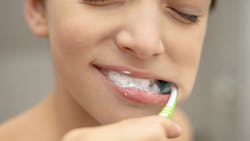Illnesses and toothbrushes: The effects of bacteria and ways to stay healthy
Wintertime is often known as cold and flu season—a time when there is an increase in viral infections. Medical professionals report that the average American adult has two to three colds a year, while a child may have more.1 One report noted an annual average of 8% of the American population contracts the influenza virus.2
Scientists attribute the increased spread of viral illness to lower humidity and the population being in closer contact indoors during the winter months.3 When patients feel unwell, it is advised that they stay away from dental offices and clinics until the contagious period is over, typically when symptoms subside and they feel better. Some patients may end up in the dental chair after recovering from a viral illness and ask if they need to change their toothbrush since they’ve been sick. Science shows there’s still debate as to whether changing toothbrushes after an illness is necessary.
Also by the author … Oral hygiene instruction: Do your patients understand its importance?
When should toothbrushes be changed?
Currently, the time frame every dental and medical professional agrees on for changing toothbrushes is every three to four months. After this period of time, toothbrushes should be swapped out because their bristles have likely worn down or altered in shape and they aren’t as effective at removing dental biofilm and food debris.4 Some dental professionals believe that just because a patient is sick does not necessarily mean they need to change their toothbrush. Other professionals argue that since the human body’s immune system makes antibodies, it protects the body from reinfection.5 True, viruses can live on a toothbrush for several days, but the odds of reinfection after the patient has gotten over the virus are slim due to the antibodies’ memory.5
Not all illnesses are the same
But not all illnesses are the same, so bacterial infections need to be examined more closely when it comes to toothbrushes and reinfection. Bacterial infections, because they can reproduce their own food and live for a long time on a toothbrush, are more likely to reinfect a patient.6 Patients should replace their toothbrush after being sick if they want to avoid reinfection.6
The key is whether the patient sought medical attention and got tested to know what illness they were diagnosed with. Were they prescribed an antibiotic? If a patient reports they took an antibiotic recently to treat their illness, the dental professional should suggest they replace their toothbrush. Further, dental professionals must remind patients that while they may have antibodies to a viral infection, others in their home may not.
Also by the author … Holistic dentistry: What to know about natural dental home-care products
Research has shown that bacteria can spread from one infected toothbrush to another.4-7 Toothbrushes that are stored together in places such as drawers, cabinets, or holders may be passing bacteria between one another because the bristles are close enough to touch. Patients may feel like all toothbrushes should be replaced if one household member was sick and others were not to prevent the chance of further infections.
Can toothbrushes be cleaned at home?
Additional discussion lies with whether patients can “clean” a toothbrush at home rather than disposing of it and replacing it after they’ve been ill. Dental patients may ask their clinician about caring for a toothbrush so that it can be kept rather than disposed of after an illness. Science has shown there is no effective measure of cleaning a toothbrush at home so that it is sanitized (no living organisms on the toothbrush.)8 Patients, however, can do a few things to disinfect their toothbrush so it stays in a more stable environment for bacteria. Above all, science directs us to always rinse a toothbrush after using it, and then let it air-dry.4,7,8 These are the best steps for preventing bacterial growth; since a lot of the bacteria are anaerobic, the air-drying method wipes out many bacteria on its own.4,7,8
Beware dishwashers, microwaves, and UV lights
The Centers for Disease Control and Prevention (CDC) and the American Dental Association (ADA) both recommend that patients not place toothbrushes in the dishwasher or microwave to disinfect them. Some patients believe the heat from those appliances will clean toothbrushes, but they don’t get hot enough to do so. Dishwashers and microwaves have been shown to alter the shape of the toothbrush so it’s not as effective.
The ADA also cautions patients against using disinfecting UV lights and mouthwash to clean toothbrushes. The UV lights are misleading; research has shown that some believe UV lights will kill all the germs on a toothbrush, but they do not. Research reveals that UV lights can also damage a toothbrush’s capabilities after extended periods of exposure, like in a dishwasher or microwave.
Finally, some people believe soaking a germ-filled toothbrush in an antiseptic mouthwash will eliminate any bacteria on the bristles. Unfortunately, more harm than good can come from this procedure, because research shows the bacteria is often not removed from the toothbrush and that the mouthwash may cross-contaminate others.5,8
Also by the author … Chlorhexidine mouthwash: Still the best choice for dental patients?
Best practices for dental professionals
Dental professionals should use their own best judgment when it comes to helping patients decide how to treat their toothbrush after being sick. Ask if the patient had to treat their illness with antibiotics or if multiple household members have also been ill. Doing so may help determine if their toothbrush is safe or if it needs to be replaced. Dental professionals can also remind patients that daily habits such as letting a toothbrush air-dry help keep it cleaner. Talk to your patients about how practices such as sticking the toothbrush in the dishwasher, microwave, or a mouthwash solution are not recommended cleaning methods. Above all, advise patients to change their toothbrushes about every three months. Whether they are sick or not, switching out toothbrushes periodically is always a good thing to do.
Editor’s note: This article first appeared in Through the Loupes newsletter, a publication of the Endeavor Business Media Dental Group. Read more articles and subscribe to Through the Loupes.
References
- Common cold. Centers for Disease Control and Prevention. National Center for Emerging and Zoonotic Infectious Diseases. Division of Healthcare Quality Promotion. Updated June 27, 2023. https://www.cdc.gov/antibiotic-use/colds.html
- Key facts about influenza (flu). Centers for Disease Control and Prevention. National Center for Immunization and Respiratory Diseases. Updated October 24, 2022. https://www.cdc.gov/flu/about/keyfacts.htm
- Pratt E. You’re more likely to get sick in winter — but not for the reasons you think. Healthline. September 19, 2019. https://www.healthline.com/health-news/sick-in-rainy-weather-reasons
- American Dental Association. Department of Scientific Information, Evidence Synthesis & Translation Research, ADA Science & Research Institute, LLC. Updated October 7, 2022. https://www.ada.org/resources/research/science-and-research-institute/oral-health-topics/toothbrushes
- Herndon K. Do you need to replace your toothbrush after you’ve been sick? Updated January 10, 2023. Verywell Health. https://www.verywellhealth.com/should-i-replace-my-toothbrush-after-ive-been-sick-770715#Do%20Germs%20Stay%20on%20Your%20Toothbrush
- Should you change your toothbrush after getting sick? Rother Dental. December 22, 2021. https://rotherdental.com/blog/should-you-change-your-toothbrush-after-getting-sick/
- Use and handling of toothbrushes. Centers for Disease Control and Prevention. Division of Oral Health. National Center for Chronic Disease Prevention and Health Promotion. Updated March 25, 2016. https://www.cdc.gov/oralhealth/infectioncontrol/faqs/toothbrush-handling.html
- Toothbrush care, cleaning and replacement. Journal of the American Dental Association. March 2006. https://jada.ada.org/action/showPdf?pii=S0002-8177%2814%2960924-7
Tracee S. Dahm, MS, BSDH, RDH, is an adjunct clinical instructor for the North Idaho College School of Dental Hygiene in Coeur d’Alene, Idaho. Tracee also works in private practice. Her research interests include trends in dental hygiene and improving access to dental care for the underserved. She can be reached at [email protected].
About the Author
Tracee S. Dahm, MS, BSDH, RDH
Tracee S. Dahm, MS, BSDH, RDH, is an adjunct clinical instructor for the North Idaho College School of Dental Hygiene in Coeur d’Alene, Idaho, and she also works in private practice. She has been published in several dental journals, magazines, webinars, and textbooks. Tracee is a key opinion leader on cutting-edge innovations in the hygiene field. Her research interests include trends in dental hygiene, improving access to dental care for the underserved, and mental health. Contact her at [email protected].

